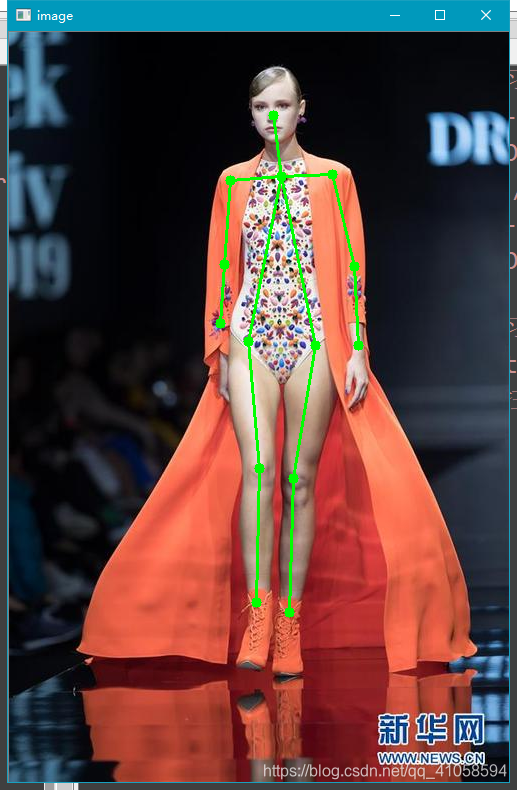版权声明:原创 https://blog.csdn.net/qq_41058594/article/details/88628576
最近在搞人脸识别,Yolo,Dlib,单纯向量法都玩了一遍,效果还可以。
昨天由老师给我发了一个百度AI的链接,我就玩开了上面的一个demo,叫做人体姿态检测出,这个名词名副其实,其背后的数学原理和论文都相当的给力,不得不佩服那些人工智能算法科学家,这也激发着我对AI的探索和学习的乐趣!
主函数,
功能:1.主要是针对百度AI接口
---------2.利用 from aip import AipBodyAnalysis #人体分析模块
# ━━━━━神兽出没━━━━━━
# ┏┓ ┏┓
# ┏┛┻━━━┛┻┓
# ┃ ┃
# ┃ ━ ┃
# ┃ ┳┛ ┗┳ ┃
# ┃ ┃
# ┃ ┻ ┃
# ┃ ┃
# ┗━┓ ┏━┛Code is far away from bug with the animal protecting
# ┃ ┃ 神兽保佑,代码无bug
# ┃ ┃
# ┃ ┗━━━┓
# ┃ ┣┓
# ┃ ┏┛
# ┗┓┓┏━┳┓┏┛
# ┃┫┫ ┃┫┫
# ┗┻┛ ┗┻┛
#
# ━━━━━━感觉萌萌哒━━━━━━
'''人体关键点识别(14个)'''
# 与human_detection 功能相同
import configparser # 配置文件模块 读写配置文件
from aip import AipBodyAnalysis #人体分析模块
import joint
import cv2
import os
然后就是一个类 class BaiDuAPI(object):
class BaiDuAPI(object):
#特殊 构造函数 初始化函数
def __init__(self,filePath):
target = configparser.ConfigParser()
target.read(filePath,encoding='utf-8-sig')
app_id = target.get('工单密码','APP_ID')
api_key = target.get('工单密码', 'API_KEY')
secret_key = target.get('工单密码', 'SECRET_KEY')
self.client = AipBodyAnalysis(app_id, api_key, secret_key)
""" 读取图片 """
def get_file_content(self,photoPath):
with open(photoPath, 'rb') as fp:
return fp.read()
""" 主函数 """
def file_main(self,photoPath):
img = self.get_file_content('{}'.format(photoPath))
""" 调用人体关键点识别 """
#此处只能对一个人进行关键点识别
#也就是说一个图片如果有好多人的话,只能标出一个人的关节特征
#此处可以做修改,即进行把一张图所有人的关节特征都表达出来
#------
# print(self.client.bodyAnalysis(img))
result = self.client.bodyAnalysis(img)['person_info'][0]['body_parts']
jo = joint.Joint(result)
jo.xunhun(photoPath)
#print(result )
从此处运行
if __name__ == '__main__':
print('---------正在检测-----------')
baiduapi = BaiDuAPI('human_detection.ini')
baiduapi.file_main('model.jpg')
print('---------检测完成-----------')
重点来了…让我们一起看效果!
滴滴滴~~~~


效果还行,把人体的14个主要关节都展示了出来…
由上面主代码我们可以看到一个这个模块: import joint
这个代码是我自己写的,用来连接着这14个点:
老规矩,看开头:
"""
# @
# 010
# 0 1 0
# 1
# 0 0
# 0 0
#opencv画实心点: cv2.circle(img,(100,63),55,(255,0,0),-1)
#dic = {
# 'neck': {
# 'y': 827.8070678710938,
# 'x': 728.5543212890625},
# 'left_shoulder':{
# 'y': 827.8095703125,
# 'x': 895.0614624023438},
# 'left_knee': {
# 'y': 1871.223754882812,
# 'x': 901.9971313476562},
# 'left_ankle': {
# 'y': 2261.0341796875,
# 'x': 867.317138671875},
# }
#for di in dic:
# print(dic[di],end=',')
#In [2]: neck,left_shoulder,left_knee,left_ankle
主要部分在这里:
class Joint(object):
__circle_list = []
def __init__(self,dic):
self.dic = dic
def draw_line(self,img):
#nose ---> neck
cv2.line(img, (int(self.dic['nose']['x']),int(self.dic['nose']['y'])),
(int(self.dic['neck']['x']),int(self.dic['neck']['y'])), (0,255,0), 2)
#neck --> left_shoulder
cv2.line(img, (int(self.dic['neck']['x']),int(self.dic['neck']['y'])),
(int(self.dic['left_shoulder']['x']),int(self.dic['left_shoulder']['y'])), (0,255,0), 2)
#neck --> right_shoulder
cv2.line(img, (int(self.dic['neck']['x']),int(self.dic['neck']['y'])),
(int(self.dic['right_shoulder']['x']),int(self.dic['right_shoulder']['y'])), (0,255,0), 2)
#left_shoulder --> left_elbow
cv2.line(img, (int(self.dic['left_shoulder']['x']),int(self.dic['left_shoulder']['y'])),
(int(self.dic['left_elbow']['x']),int(self.dic['left_elbow']['y'])), (0,255,0), 2)
#left_elbow --> left_wrist
cv2.line(img, (int(self.dic['left_elbow']['x']),int(self.dic['left_elbow']['y'])),
(int(self.dic['left_wrist']['x']),int(self.dic['left_wrist']['y'])), (0,255,0), 2)
#right_shoulder --> right_elbow
cv2.line(img, (int(self.dic['right_shoulder']['x']),int(self.dic['right_shoulder']['y'])),
(int(self.dic['right_elbow']['x']),int(self.dic['right_elbow']['y'])), (0,255,0), 2)
#right_elbow --> right_wrist
cv2.line(img, (int(self.dic['right_elbow']['x']),int(self.dic['right_elbow']['y'])),
(int(self.dic['right_wrist']['x']),int(self.dic['right_wrist']['y'])), (0,255,0), 2)
#neck --> left_hip
cv2.line(img, (int(self.dic['neck']['x']),int(self.dic['neck']['y'])),
(int(self.dic['left_hip']['x']),int(self.dic['left_hip']['y'])), (0,255,0), 2)
#neck --> right_hip
cv2.line(img, (int(self.dic['neck']['x']),int(self.dic['neck']['y'])),
(int(self.dic['right_hip']['x']),int(self.dic['right_hip']['y'])), (0,255,0), 2)
#left_hip --> left_knee
cv2.line(img, (int(self.dic['left_hip']['x']),int(self.dic['left_hip']['y'])),
(int(self.dic['left_knee']['x']),int(self.dic['left_knee']['y'])), (0,255,0), 2)
#right_hip --> right_knee
cv2.line(img, (int(self.dic['right_hip']['x']),int(self.dic['right_hip']['y'])),
(int(self.dic['right_knee']['x']),int(self.dic['right_knee']['y'])), (0,255,0), 2)
#left_knee --> left_ankle
cv2.line(img, (int(self.dic['left_knee']['x']),int(self.dic['left_knee']['y'])),
(int(self.dic['left_ankle']['x']),int(self.dic['left_ankle']['y'])), (0,255,0), 2)
#right_knee --> right_ankle
cv2.line(img, (int(self.dic['right_knee']['x']),int(self.dic['right_knee']['y'])),
(int(self.dic['right_ankle']['x']),int(self.dic['right_ankle']['y'])), (0,255,0), 2)
def xunhun(self,img):
im1 = cv2.imread(img,cv2.IMREAD_COLOR)
#im2 = cv2.resize(im1, (500,900), interpolation=cv2.INTER_CUBIC)
for i in self.dic:
cv2.circle(im1,(int(self.dic[i]['x']),int(self.dic[i]['y'])),5,(0,255,0),-1)
self.draw_line(im1)
cv2.imshow('image',im1)
百度AI 只是给了我们一个平台,免费的使用,以达到快速开发的目的…
分享几个链接:
【人体分析-人像分割】API示例Python
通用图像分析——通用物体和场景识别高级版
抖音上线“尬舞机”应用“人体关键点检测”技术